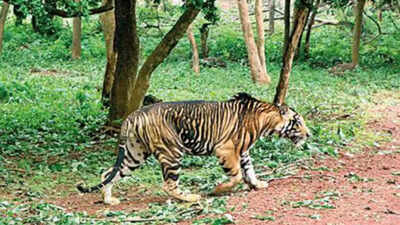- News
- City News
- bhubaneswar News
- Nandankanan tigers' melanistic gene pool found at 3 more zoos in country
Nandankanan tigers' melanistic gene pool found at 3 more zoos in country

A melanistic tiger at Nandankanan, Bhubaneswar on Thursday
BHUBANESWAR: The Nandankanan Zoological Park here, the first in the country to have zoo-born melanistic tigers, boasts of such a gene pool at three other zoos in Ranchi, Chennai and Indore.
Melanistic or black-striped tigers are born because of a genetic drift, which means random fluctuations in the numbers of gene variants in a population. After seeing the birth of its first melanistic big cat in July 2014, the Nandankanan authorities started regulated breeding. Six years later, it sent a melanistic tiger, Vicky, to the Indore zoo in 2020. Now Nandankanan has three such big cats - Krishan, Basu and Spandan.
"All the melanistic tigers bred in Indian zoos have a link with the Nandankanan population. The first melanistic tiger born eight years ago in the zoo traces its ancestry to the tigers of Similipal Tiger Reserve, which is known as the only sanctuary in the world, where melanistic tigers are found in the wild," zoo deputy director Dr Sanjeet Kumar said.
The top zoo custodian said researchers of the National Centre for Biological Sciences, Bengaluru led by a senior molecular ecologist Uma Ramakrishnan, have found that a single mutation in the gene Trans-membrane Aminopeptidase Q (Taqpep) causes the tigers to develop black stripes and a distinct pattern.
"We are undertaking planned and regulated breeding of tigers with a special focus on heterozygosity," Kumar said.
Earlier, the Similipal authorities had said the tigers being called melanistic in Similipal are actually pseudo-melanistic because they have black stripes with yellow ones interspersed on their bodies. “So far our knowledge and study goes, melanistic tigers are born if there is genetic repetition in mating,” a wildlife officer said.
Putting forth another view, former member secretary of the National Tiger Conservation Authority and the Similipal field director, Anup Nayak, said melanistic tigers were first sighted in Similipal in 2007. “Having a melanistic breed of big cats in a reserve indicates that there is restricted breeding without genetic variations,” he added.
The zoo authorities said no special attention is given to help the melanistic tigers breed in the zoo. “In terms of behaviour and food, they are as good as the yellow-striped Royal Bengal Tigers. More research on melanistic tigers is being carried out in different zoos,” a zoo official said.
Melanistic or black-striped tigers are born because of a genetic drift, which means random fluctuations in the numbers of gene variants in a population. After seeing the birth of its first melanistic big cat in July 2014, the Nandankanan authorities started regulated breeding. Six years later, it sent a melanistic tiger, Vicky, to the Indore zoo in 2020. Now Nandankanan has three such big cats - Krishan, Basu and Spandan.
"All the melanistic tigers bred in Indian zoos have a link with the Nandankanan population. The first melanistic tiger born eight years ago in the zoo traces its ancestry to the tigers of Similipal Tiger Reserve, which is known as the only sanctuary in the world, where melanistic tigers are found in the wild," zoo deputy director Dr Sanjeet Kumar said.
The top zoo custodian said researchers of the National Centre for Biological Sciences, Bengaluru led by a senior molecular ecologist Uma Ramakrishnan, have found that a single mutation in the gene Trans-membrane Aminopeptidase Q (Taqpep) causes the tigers to develop black stripes and a distinct pattern.
"We are undertaking planned and regulated breeding of tigers with a special focus on heterozygosity," Kumar said.
Earlier, the Similipal authorities had said the tigers being called melanistic in Similipal are actually pseudo-melanistic because they have black stripes with yellow ones interspersed on their bodies. “So far our knowledge and study goes, melanistic tigers are born if there is genetic repetition in mating,” a wildlife officer said.
Putting forth another view, former member secretary of the National Tiger Conservation Authority and the Similipal field director, Anup Nayak, said melanistic tigers were first sighted in Similipal in 2007. “Having a melanistic breed of big cats in a reserve indicates that there is restricted breeding without genetic variations,” he added.
The zoo authorities said no special attention is given to help the melanistic tigers breed in the zoo. “In terms of behaviour and food, they are as good as the yellow-striped Royal Bengal Tigers. More research on melanistic tigers is being carried out in different zoos,” a zoo official said.
FOLLOW US ON SOCIAL MEDIA
FacebookTwitterInstagramKOO APPYOUTUBE

Start a Conversation
end of article










